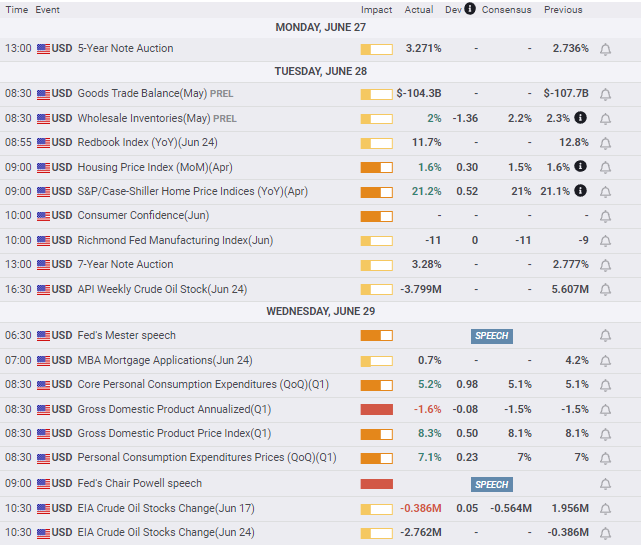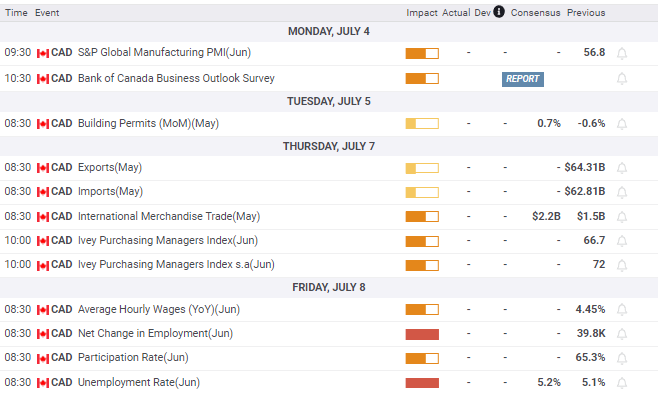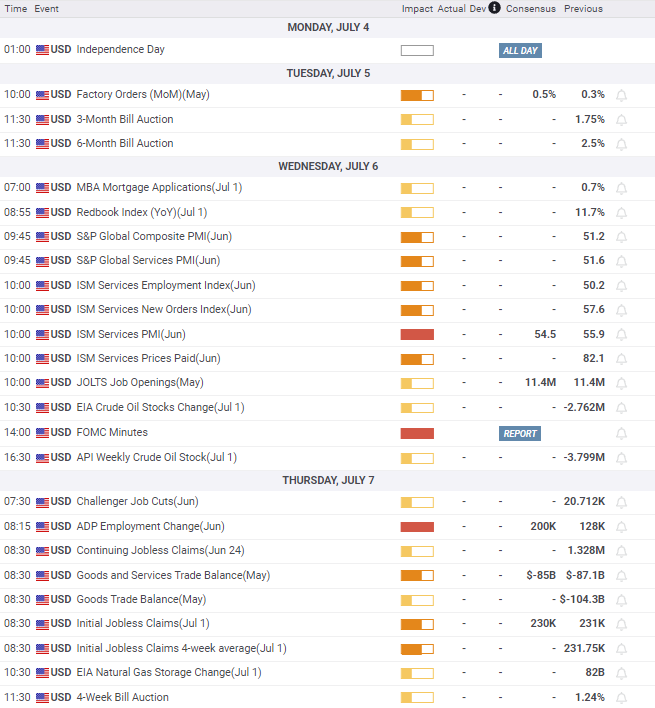- US dollar gains 1.9% in the half-year, 3.1% for the quarter.
- Treasury yields fall sharply, the US 10-year slips below 3.0%.
- American economic data weakens, hinting at recession.
- FXStreet Forecast Poll sees a stronger loonie.
The Canadian dollar has had the best half-year among the majors, still a loser but down the least of all the major currencies, and especially of the commodity pairs. The loonie was aided by a 42% rise in West Texas Intermediate (WTI) from January which helped blunt the US dollar's safety-surge after the Russian invasion of Ukraine at the end of February.
For the past three weeks it has been a straight US dollar run. The USD/CAD has climbed 2.9% since June 7 as six-month and quarterly repositioning has favored the greenback and a 9.7% drop in WTI crippled the Canadian currency.
The Federal Reserve’s pivot on inflation and the subsequent rise in US rates has assisted the US dollar, but less so than against other currencies because Canadian sovereign rates have also moved rapidly higher. Canada’s inflation rate reached 7.7% in May, less than the 8.6% south of the border but more than enough to keep speculation alive for a 75 basis or 100 point hike at the Bank of Canada’s (BoC) next meeting on July 13.
For the week the USD/CAD was unchanged, opening at 1.2891 and finishing at 1.2989. Crude oil was slightly higher, starting at $106.16 and closing at $106.72. Treasury yields fell in the US. The return of the 10-year note dropped 31 points to 2.894%, almost triple the 11 point loss on the Canadian bond to 3.225%.
Credit markets reflected the Federal Reserve’s inflation rate program, more than doubling the 10-year yield from its 2021 close at 1.514% to its June 14 high at 3.480%.
Federal Reserve officials continued their rhetorical flourishes against inflation. Appearing at an ECB forum with the Bank of England’s Andrew Bailey and Christine Lagarde head of the host bank, Fed chair Jerome Powell insisted that higher inflation will not be allowed to become endemic.
“Our job is literally to prevent that from happening, and we will prevent that from happening,” he said. “We will not allow a transition from a low-inflation environment into a high-inflation environment.”
Canadian data was almost nonexistent this week with just April GDP reported as expected at 0.3% to no notice whatsoever.
Data from the US suggested that the economy is rapidly weakening while inflation remains untamed.
The Personal Consumption Expenditures Price Index (PCE), the Federal Reserve's chosen inflation gauge rose 6.3% for the year in May, close to its 40-year top of 6.6% from March. The core rate slipped to 4.7% from 4.9% as expected.
Real Personal Income and Spending, adjusted for prices, were both negative in May. The Purchasing Managers Index (PMI) for manufacturing from the Institute for Supply Management (ISM) slipped to 53 in June, from 56.1 prior and missed its 54.9 forecast. The indexes for Employment and New Orders dropped below 50 into contraction, with new business at its lowest level since March 2020 at the height of the pandemic lockdown.
The Atlanta Fed’s widely followed GDPNow model rated second quarter growth at -1%, its first contraction, bringing the possibility of a first-half recession dramatically to life. First quarter annualized GDP was revised to -1.6% from -1.5%.
USD/CAD outlook
The 1.2500 to 1.3000 range of the last six months is not in danger. Fed and BoC policy are very close in intent and execution. Crude oil has stabilized in the $105-$115 area and while a prolonged move up or down is the most likely catalyst for a break-out in the USD/CAD the commodity market logic is lacking.
A recession in the US acting as a leader for the global economy would cut demand and prices would follow. The negative impact of lower oil on Canada’s economy and the loonie would be balanced by a probable fall in US Treasury rates. The differential for the USD/CAD would depend on the competing attitudes of the BoC and the Fed which is unknown as neither bank has publicly addressed the policy implication of a domestic recession.
American information will again dominate market results, led by the minutes of the June 15 Federal Open Market Committee (FOMC) meeting and Nonfarm Payrolls for June on Friday. The governors’ thinking on a US recession is the chief interest in the minutes. How will Fed policy evolve if the US does strike a recession in the second quarter. Services PMI will be examined for confirmation of the steep drop in manufacturing New Orders Index. If new business in the far larger service sector follows manufacturing into contraction, the odds of a recession rise and so will the pressure on US Treasury rates.
Canada’s Net Change in Employment will accompany the NFP release. S&P Global Manufacturing and the Ivey PMIs for June will provide information but no market notice.
The outlook for the USD/CAD is neutral as recession fears chip away at WTI and US Treasury rates.
Canada statistics June 27–July 1
US statistics June 27–July 1
Canada statistics July 4–July 8
FXStreet
US statistics July 4–July 8
FXStreet
USD/CAD technical outlook
The MACD (Moving Average Convergence Divergence) cross of the signal line on Thursday has not widened into a clear sell signal. Likewise the Relative Strength Index location near the neutral line evinces no plain advice. Average True Range (ATR) volatility has been declining for two weeks.
Moving averages: 21-day 1.2839, 50-day 1.2829, 100-day 1.2739, 200-day 1.2681
Resistance: 1.2930, 1.2950, 1.3000, 1.3075
Support: 1.2890, 1.2860, 1.2845, 1.2825
FXStreet Forecast Poll
The FXStreet Forecast Poll portrays a stronger Canadian dollar but in reality the USD/CAD is simply headed to the center of its range.
Information on these pages contains forward-looking statements that involve risks and uncertainties. Markets and instruments profiled on this page are for informational purposes only and should not in any way come across as a recommendation to buy or sell in these assets. You should do your own thorough research before making any investment decisions. FXStreet does not in any way guarantee that this information is free from mistakes, errors, or material misstatements. It also does not guarantee that this information is of a timely nature. Investing in Open Markets involves a great deal of risk, including the loss of all or a portion of your investment, as well as emotional distress. All risks, losses and costs associated with investing, including total loss of principal, are your responsibility. The views and opinions expressed in this article are those of the authors and do not necessarily reflect the official policy or position of FXStreet nor its advertisers. The author will not be held responsible for information that is found at the end of links posted on this page.
If not otherwise explicitly mentioned in the body of the article, at the time of writing, the author has no position in any stock mentioned in this article and no business relationship with any company mentioned. The author has not received compensation for writing this article, other than from FXStreet.
FXStreet and the author do not provide personalized recommendations. The author makes no representations as to the accuracy, completeness, or suitability of this information. FXStreet and the author will not be liable for any errors, omissions or any losses, injuries or damages arising from this information and its display or use. Errors and omissions excepted.
The author and FXStreet are not registered investment advisors and nothing in this article is intended to be investment advice.
Recommended Content
Editors’ Picks
AUD/USD hovers around 0.6500 amid light trading, ahead of US GDP

AUD/USD is trading close to 0.6500 in Asian trading on Thursday, lacking a clear directional impetus amid an Anzac Day holiday in Australia. Meanwhile, traders stay cautious due ti risk-aversion and ahead of the key US Q1 GDP release.
USD/JPY finds its highest bids since 1990, near 155.50

USD/JPY keeps breaking into its highest chart territory since June of 1990 early Thursday, testing 155.50 for the first time in 34 years as the Japanese Yen remains vulnerable, despite looming Japanese intervention risks. Focus shifts to Thursday's US GDP report and the BoJ decision on Friday.
Gold stays firm amid higher US yields as traders await US GDP data

Gold recovers from recent losses, buoyed by market interest despite a stronger US Dollar and higher US Treasury yields. De-escalation of Middle East tensions contributed to increased market stability, denting the appetite for Gold buying.
Ethereum suffers slight pullback, Hong Kong spot ETH ETFs to begin trading on April 30

Ethereum suffered a brief decline on Wednesday afternoon despite increased accumulation from whales. This follows Ethereum restaking protocol Renzo restaked ETH crashing from its 1:1 peg with ETH and increased activities surrounding spot Ethereum ETFs.
Dow Jones Industrial Average hesitates on Wednesday as markets wait for key US data

The DJIA stumbled on Wednesday, falling from recent highs near 38,550.00 as investors ease off of Tuesday’s risk appetite. The index recovered as US data continues to vex financial markets that remain overwhelmingly focused on rate cuts from the US Fed.








 tech 1-637923066966730124.png)
 tech 2-637923071491407175.png)
